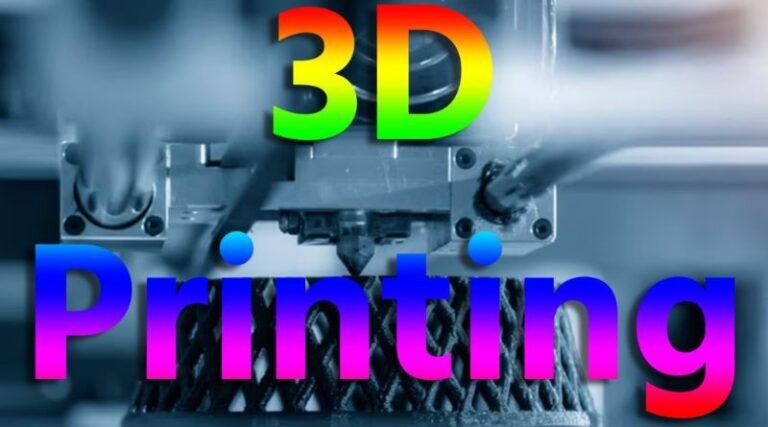How 3D Printing is Disrupting Traditional Manufacturing Processes
3D printing, also known as additive manufacturing, is transforming the way industries approach production, design, and logistics. What was once a niche technology for prototyping has now become a disruptive force in traditional manufacturing, offering benefits that range from cost savings to enhanced customization. But what exactly makes 3D printing such a game-changer, and how is it reshaping manufacturing processes? Let’s dive into the details.
Speed and Efficiency
One of the most significant advantages of 3D printing over traditional manufacturing methods is its ability to streamline production timelines. Traditional manufacturing, which typically involves molding, casting, or machining, requires multiple steps and extensive setup. Each stage — from tooling to assembly — introduces delays, especially when small adjustments are needed for product development.
3D printing bypasses many of these complexities. By building objects layer by layer, manufacturers can produce parts directly from digital designs, reducing lead times from weeks to mere hours or days. This agility allows for rapid prototyping, faster iteration, and quicker product launches. As a result, companies can get products to market faster, outpacing competitors who rely on slower, more conventional manufacturing methods.
Customization and Personalization
Traditional manufacturing often thrives on economies of scale, meaning the more units produced, the cheaper each one becomes. However, this model limits the ability to produce unique or customized items without incurring significant costs.
In contrast, 3D printing excels in creating one-off, custom-designed parts at a fraction of the cost of traditional methods. Since designs are digitally controlled, manufacturers can easily tweak parameters like size, shape, or material composition to meet specific customer demands. This ability to customize on a large scale is revolutionizing industries such as healthcare, where patient-specific implants, prosthetics, and dental devices are produced using 3D printing technology.
Reducing Material Waste
Conventional manufacturing processes often involve subtractive methods, where raw materials are cut, drilled, or shaped to create the final product. This can result in significant material waste, driving up costs and impacting sustainability efforts. For industries focused on reducing their environmental footprint, this inefficiency poses a challenge.
3D printing, on the other hand, is an additive process that builds objects layer by layer, using only the exact amount of material required. This results in little to no waste, making it a more environmentally friendly option. The ability to recycle materials within the 3D printing process further amplifies its green credentials. Manufacturers can now balance profitability with sustainability by adopting this waste-reducing technology.
Complex Geometries Made Simple
Traditional manufacturing techniques often struggle to create complex geometries, especially when intricate internal structures are involved. To produce such parts, manufacturers may need multiple molds, tools, or machining operations, driving up costs and production time.
3D printing excels in producing intricate, complex designs that would be difficult or impossible to achieve using conventional methods. The technology enables the creation of lightweight parts with intricate lattice structures, improving strength-to-weight ratios without sacrificing durability. This advantage has significant implications for industries such as aerospace, automotive, and medical, where component performance is critical, and weight reductions can lead to substantial improvements in efficiency.
Lower Production Costs
While traditional manufacturing requires expensive tooling and setup, especially for short production runs, 3D printing eliminates much of this overhead. Once a 3D printer is in place, the primary costs are the materials used and energy consumed, which are often lower than the costs of traditional production processes.
For manufacturers producing small quantities or custom items, 3D printing offers a cost-effective solution by eliminating the need for expensive molds or dies. Furthermore, the technology reduces the need for large inventories, allowing for on-demand production. This flexibility enables businesses to adapt to market changes more easily without the risk of overproduction or wasted inventory.
Supply Chain Transformation
The rise of 3D printing is also reshaping global supply chains. Traditionally, manufacturing is concentrated in areas with large production facilities, often far from end customers. Products are then shipped, sometimes across continents, adding logistical complexity and costs.
3D printing offers the possibility of localized, decentralized production. By placing 3D printers closer to consumers or end users, manufacturers can reduce shipping costs and times, minimize supply chain disruptions, and respond more quickly to demand. This shift toward localized production could fundamentally alter the way businesses operate, making them more agile and responsive to customer needs.
The Challenges Ahead
While 3D printing is disrupting traditional manufacturing in many ways, it’s not without its challenges. For instance, the speed of production, while faster than traditional methods for small runs or prototypes, may not match the efficiency of mass production for high-volume orders. Additionally, the range of materials that can be used in 3D printing, while growing, still doesn’t match the variety available in traditional manufacturing.
Regulatory issues, particularly in industries like healthcare and aerospace, can also slow the adoption of 3D-printed parts. Ensuring consistent quality and safety in printed products remains a critical hurdle that the industry must overcome.
Conclusion
3D printing is undeniably reshaping the manufacturing landscape, offering unprecedented flexibility, customization, and efficiency. As the technology continues to evolve and improve, it will undoubtedly play an even more significant role in disrupting traditional manufacturing processes. Companies that embrace 3D printing today are poised to gain a competitive edge in tomorrow’s rapidly changing industrial world. Whether it’s reducing costs, speeding up production, or minimizing environmental impact, 3D printing is proving to be a powerful tool that’s challenging the status quo of manufacturing.

